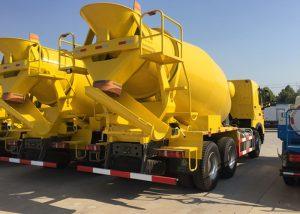Monday to Saturday - 8:00 -17:30
How Many Gallons Does an 18 Wheeler Hold?
Understanding the fuel capacity of an 18-wheeler is essential for anyone involved in freight transport, logistics, or those simply curious about the trucking industry. This comprehensive article explores various aspects of an 18-wheeler’s fuel capacity, including practical implications, types of fuel tanks, and much more.
Introduction to 18-Wheelers
18-wheelers, also known as semi-trucks or tractor-trailers, are heavy-duty trucks designed to transport goods over long distances. They are equipped with five axles and can have a total gross weight of up to 80,000 pounds, subject to regulations. One of the critical components of these vehicles is their fuel tank, which significantly impacts their efficiency and operational capabilities.
Fuel Capacity of an 18-Wheeler
Standard Fuel Capacity
An 18-wheeler typically holds between 100 and 300 gallons of diesel fuel. The exact capacity can vary based on the make, model, and configuration of the truck. Most commonly, a standard 18-wheeler with dual fuel tanks can have two 150-gallon tanks, totaling 300 gallons of fuel. This capacity allows for extended travel distances before needing to refuel.
Factors Influencing Fuel Capacity
- Tank Configuration: Some trucks use a single large tank instead of dual tanks.
- Manufacturer Specifications: Different brands have different fuel tank designs.
- Regulatory Requirements: Some regions may impose tank size limits.
Comparison Table of Different 18-Wheeler Fuel Capacities
| Truck Model | Fuel Tank Type | Fuel Capacity (Gallons) |
|---|---|---|
| Freightliner Cascadia | Dual Tanks | 200 (2 x 100) |
| Kenworth T680 | Single Tank | 150 |
| Peterbilt 579 | Dual Tanks | 300 (2 x 150) |
Importance of Fuel Capacity
Long-Distance Hauling
For long-haul trucking, a large fuel capacity is crucial. It allows drivers to cover more ground without frequent stops for refueling, ensuring timely deliveries. With fuel prices fluctuating, running out of fuel can also lead to additional costs and delays.
Operational Efficiency
Higher fuel capacity can lead to better operational efficiency. More fuel means fewer refueling stops, which saves time and reduces costs associated with fuel purchases and labor. Trucking companies benefit from improved scheduling and fleet management by maximizing routes.
Types of Fuel Used by 18-Wheelers
Diesel Fuel
The most common fuel used in 18-wheelers is diesel. Diesel engines are more fuel-efficient compared to gasoline engines, offering more torque and better performance for heavy loads. This efficiency translates to lower fuel consumption over long distances.
Biodiesel and Alternative Fuels
Some trucking companies are exploring biodiesel and other alternative fuels for their fleets. These options can reduce environmental impact and sometimes offer cost savings, although they may not yet be as widely adopted as traditional diesel.
How Fuel Capacity Relates to Fuel Economy
Miles Per Gallon (MPG)
Understanding the relationship between fuel capacity and fuel economy is vital. An 18-wheeler typically achieves between 6 to 8 miles per gallon, depending on load and driving conditions. Therefore, with a maximum capacity of 300 gallons, a truck can travel approximately 1,800 to 2,400 miles on a full tank under ideal conditions.
Real-World Examples
For instance, if a truck driver covering a route from Los Angeles to New York (approximately 2,800 miles) averages 6 MPG, they would need around 467 gallons to complete the trip. Therefore, they would need to plan at least one refueling stop even with a full tank of 300 gallons.
Refueling Strategies for Truck Drivers
Planning Routes
Truck drivers must plan their routes carefully, identifying refueling stations along the way. Using fuel-efficient routes can help minimize stops while ensuring that fuel is available when needed.
Tracking Fuel Usage
Using electronic logging devices and fleet management software, drivers can track fuel usage more accurately. This information helps in optimizing fuel consumption, scheduling maintenance, and planning future routes.
Maintenance and Fuel Tank Care
Regular Inspections
Regular maintenance of fuel tanks is crucial for preventing leaks and ensuring optimal performance. Drivers should inspect fuel tanks periodically for any signs of damage and have them cleaned regularly to prevent sediment build-up.
Keeping Fuel Fresh
Diesel fuel can degrade over time, especially if the truck is not used frequently. Using additives can help keep diesel fuel fresh and prevent microbial growth in the fuel tank.
Environmental Considerations
Fuel Emissions and Regulations
Environmental regulations are becoming increasingly strict for fuel emissions from heavy-duty trucks. Understanding fuel capacity and its impact on emissions is crucial for compliance. Companies must be aware of how much fuel they use and adopt practices to minimize their carbon footprint.
Innovations in Trucking Fuel
Many companies are exploring alternative fuels and electric vehicles as part of a transition to sustainable energy sources. These innovations aim to reduce reliance on fossil fuels and lessen environmental impacts.
FAQ Section
1. What is the average fuel capacity of an 18-wheeler?
The average fuel capacity ranges from 100 to 300 gallons, depending on the model and tank configuration.
2. How far can an 18-wheeler travel on a full tank?
With a full tank of 300 gallons, an 18-wheeler can travel between 1,800 to 2,400 miles, assuming an average of 6 to 8 miles per gallon.
3. What fuel is primarily used in 18-wheelers?
Diesel fuel is the primary fuel used in 18-wheelers due to its efficiency and performance characteristics.
4. How does fuel tank maintenance affect performance?
Regular fuel tank maintenance prevents leaks, maintains fuel quality, and ultimately ensures better performance and efficiency.
5. Are there alternative fuels for 18-wheelers?
Yes, biodiesel and other alternative fuels are being explored as options to reduce environmental impact.
6. What factors influence the fuel capacity of an 18-wheeler?
Tank configuration, manufacturer specifications, and regulatory requirements are the primary factors influencing fuel capacity.









